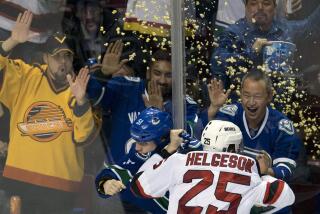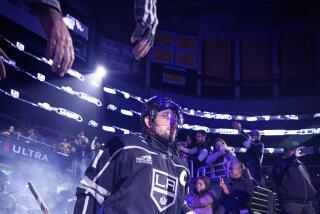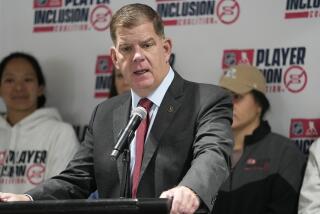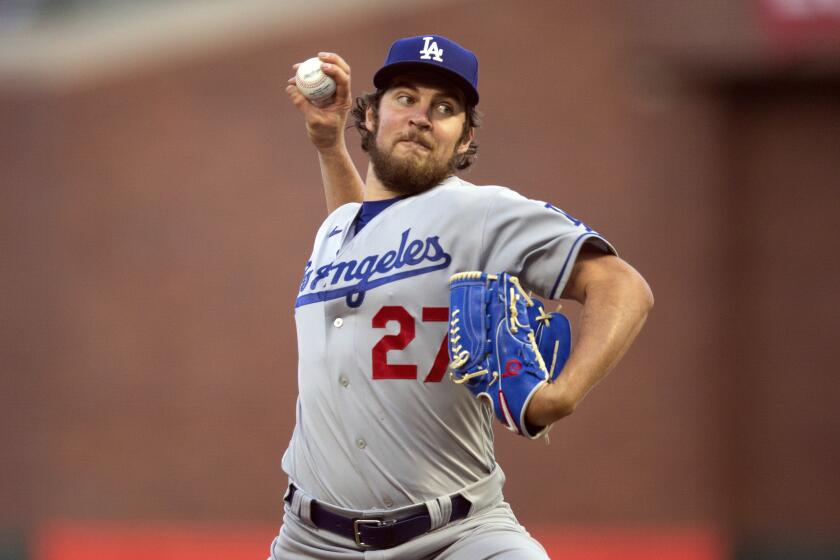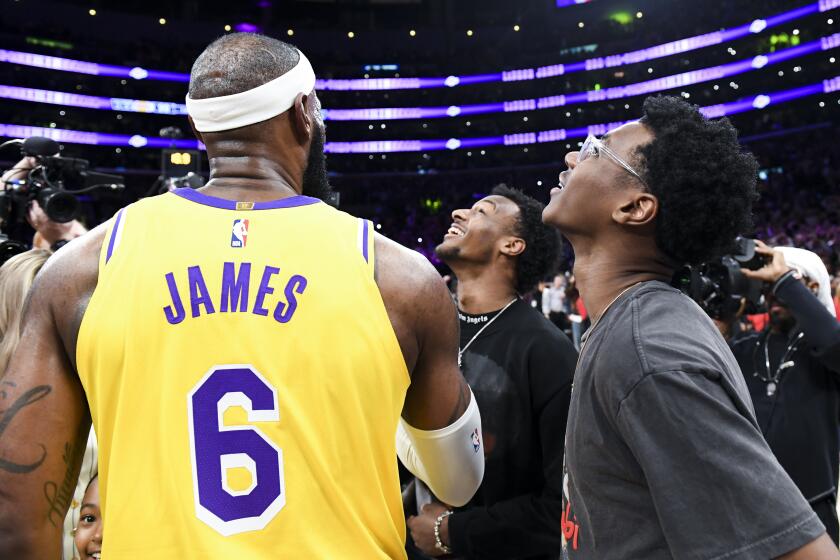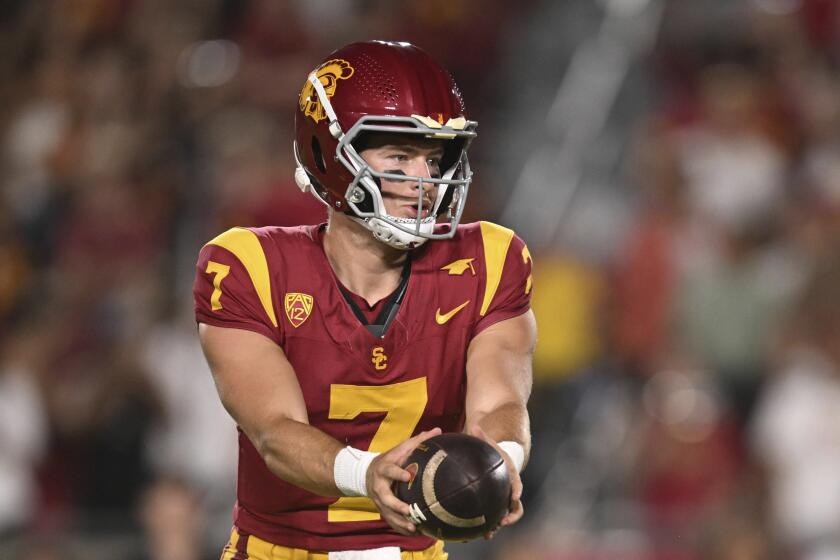Hard life of hockey enforcers on display in documentary
The first scene of “The Last Gladiators,” a documentary that brings extraordinary insight to hockey’s vanishing breed of enforcers, features a closeup of a man’s hands. It takes only a few seconds to realize who they belong to and how appropriate that image is.
The hands are scarred, the fingers misshapen and the knuckles flattened. They’re surprisingly small.
“I have my mother’s hands,” a raspy voice says, turning those hands toward the camera for better inspection.
The voice and hands belong to Chris “Knuckles” Nilan, one of the NHL’s most feared fighters during an era when enforcers were featured players. Those hands also provide the road map of a life that veered painfully off track and is, day by day, being reined in with the same sheer will that propelled this rough-edged kid from Boston into the NHL and got his name onto the Stanley Cup as a member of the Montreal Canadiens in 1986.
“I’m living life instead of just surviving now,” he said during a telephone interview.
Nilan, a month short of 55, is the most powerful figure in this 90-minute documentary directed by Alex Gibney, a 2007 Academy Award winner for the documentary “Taxi to the Dark Side.” The film debuted at the Toronto Film Festival in 2011 and is poised for U.S. distribution, including video-on-demand release on Feb. 8.
Former King Marty McSorley, the late Bob Probert, “regretful” tough guy Todd Ewen, scary Tony Twist, Donald Brashear and Lyndon Byers also appear to discuss their roles in protecting their smaller, more skillful teammates. The enforcer, unique to hockey, is becoming rare: Kevin Westgarth didn’t play at all during the Kings’ Stanley Cup run, and he’s not alone. Smaller rosters mean coaches can’t devote a spot to someone who can only fight, and enforcers usually crack the lineup only in response to specific situations or incidents.
Seeing Probert on screen is particularly jarring, because he died on July 5, 2010, at 45 of an apparent heart attack following heavy drug and alcohol abuse. Nilan said filming of the documentary began in 2009.
“I remember the day he filmed that. I was with him in Ontario playing old timers’ hockey,” Nilan said. “It’s sad what happened with him.”
Nilan went down much the same path as Probert — his poisons were painkillers after some 30 surgeries and later heroin — but he’s here to tell his tale and said he will mark five years of sobriety on May 5. His unflinching honesty about his best days and the bad ones that followed is gripping.
“Having kept so much inside for so long, it wasn’t painful to get it out. It actually felt good to get it out,” he said. “Going through the things that I went through personally, when they asked me to do it I kind of looked at it as an extension of my therapy.”
The Canadiens chose him 231st of 235 players in the 1978 entry draft. He fought in his first professional game in the American Hockey League and quickly found a home in Montreal. “He was the toughest guy in the league and he knew it,” former general manager Serge Savard says in the film.
But Nilan wanted more. “I wanted to be a hockey player. I didn’t just want to fight,” he says. “I wanted to be a regular player.”
He was helped by some of the game’s best: coaches Claude Ruel and Jacques Lemaire, and future Hall of Fame players Larry Robinson and Bob Gainey. He scored 21 goals and 37 points in 1984-85 — with a league-leading 358 penalty minutes — and followed that with 19 goals and 34 points as the Canadiens went on to win the Cup.
He was chosen for Team USA in the 1987 Canada Cup tournament and established himself as a crowd favorite. “The fans loved Nilan as much as the players did,” veteran hockey writer Red Fisher said.
A clash of wills with coach Jean Perron led to Nilan being traded to the New York Rangers, where he never really fit in. “It was devastating,” he says in the film. “It broke me. I never got over it.”
He finished in Boston, with his hometown Bruins, but years of hand, shoulder and knee injuries drove him out of the game at 34 with 3,043 penalty minutes to his credit. He drifted, unfocused. “I guess I didn’t feel whole without hockey in my life,” he says on camera.
Those injuries and operations put him on painkillers. He quickly became addicted and recalled falling sleep one night and awakening with a needle in his arm. “Heroin? Me? I couldn’t believe that’s me out there,” he said.
His parents, including his Green Beret father, were horrified by his struggles. His marriage failed and so did rehab efforts until he quit cold turkey.
“I went to treatment once before. I relapsed. I had surgery again and I relapsed on the pills,” he said. “This time it was a lot worse than the last time and things went downhill fast. It just wasn’t a lot of fun.
“A lot of people think you can just snap your fingers and stop. It’s very difficult when you get into pain medication like I was to say one day, ‘I’ll stop.’ The pain, sickness that comes along with trying to withdraw yourself from those drugs, it’s incomprehensible how painful it is. People have a hard time to understand it.
“It’s not like I wanted to keep doing it but I had to, more or less, to survive. It sounds kind of crazy but I was doing what I had to do to survive until I could get into a treatment center and go somewhere and get detoxed and start working on the rest of it.”
That work continues. He lives in Montreal with his girlfriend, who manages his website, https://www.knucklesnilan.com, and arranges his public-speaking engagements. On his own, he began an anti-bullying campaign aimed at kids; he estimated he has spoken at more than 100 schools in Ontario and Quebec. He also works for TSN radio and is scheduled to begin an afternoon show in a few months.
“I’m looking forward to that,” he said. “It’s been a good move for me to come back here. There’s some opportunities here for me. You’re not always welcomed back with arms wide-open. People are leery about dealing with someone who’s gone through what I’ve gone through but there are people who have welcomed me and are willing to give me a chance and that’s cool.”
He said he enjoyed last spring’s playoffs and remains a fan of the game. “Hockey is still hockey, when it comes down to it. It’s a series of one-on-one battles and making the fewest mistakes,” he said. “That will never change, though some of the rules have.
“I think there’s a place in the game for fighting, still. Although I don’t buy these guys calling each other a week before the game and saying, ‘We’re gonna fight.’ It was meant to be spontaneous. It was meant for you to stick up for players on your team. I don’t buy that other nonsense.”
If there’s anything viewers can take away from this film, he said, it’s a greater understanding of the men behind the fists.
“I enjoyed fighting. I loved fighting. I didn’t have a problem with that,” he said. “Honestly, a lot of people think that winning a fight, to me, was more exciting than scoring a goal. But it was the other way around. I liked scoring goals. And that’s the thing I’m most proud of: that I became a hockey player and I wasn’t just a fighter.
“I think this gives you an idea of what can happen too, when it’s all over. There can be redemption. You can get back on your feet no matter how low you get or what happens in your life. No matter how down and out you think you are, there’s always that possibility, and there’s always something deep down inside each and every one of us that allows us to get back on our feet and live again.”
More to Read
Get our high school sports newsletter
Prep Rally is devoted to the SoCal high school sports experience, bringing you scores, stories and a behind-the-scenes look at what makes prep sports so popular.
You may occasionally receive promotional content from the Los Angeles Times.
